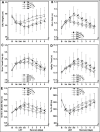Adequate Interval between Matches in Elite Female Soccer Players
- PMID: 38045739
- PMCID: PMC10690515
- DOI: 10.52082/jssm.2023.614
Adequate Interval between Matches in Elite Female Soccer Players
Retraction in
-
RETRACTION: Adequate Interval between Matches in Elite Female Soccer Players.J Sports Sci Med. 2025 Sep 1;24(3):712. doi: 10.52082/jssm.2025.712. eCollection 2025 Sep. J Sports Sci Med. 2025. PMID: 40933323 Free PMC article.
Abstract
The present study compared four different intervals between three simulated soccer matches for changes in muscle damage and performance parameters. Thirteen well-trained female university soccer players performed three bouts of 90-min Loughborough Intermittent Shuttle Test (LIST) with four different intervals between bouts; one (1d), two (2d), three (3d) and four days (4d), with >12-weeks between conditions in a counterbalanced order. Heart rate, blood lactate, rating of perceived exertion and distance covered in each LIST were measured. Changes in several muscle damage markers (e.g., maximal voluntary isometric torque of the knee extensors: MVC-KE, muscle soreness), performance parameters (e.g., Yo-Yo intermittent recovery test level 1: Yo-Yo IR1), and blood measures (e.g., osmolality, high sensitivity cardiac troponin T) before the first LIST, 1 h after each LIST, and one to five days after the third LIST were compared among the conditions. The total distance covered during the first two LISTs was not different among the conditions, but that during the third LIST was shorter (P < 0.05) for the 1d (9,416 ± 885 m) and 2d conditions (9,737 ± 246 m) than the 3d (10,052 ± 490 m) and 4d conditions (10,432 ± 538 m). Changes in all measures were smaller (P < 0.05) in the 3d and 4d conditions (e.g., the decrease in MVC-KE at one day after the third LIST was -13 ± 4% and -10 ± 3%, respectively) when compared with the 1d and 2d conditions (-20 ± 7%, -18 ± 5%). Performance parameters showed smaller (P < 0.05) changes in the 4d (e.g., the decrease in Yo-Yo IR1 at one day after the third LIST was -9 ± 3%) and 3d (-13 ± 6%) conditions when compared with the 1d (-19 ± 4%) and 2d (-20 ± 8%) conditions. These results suggest that muscle damage and fatigue accumulate when soccer matches are performed three consecutive days or every other day, but if more than three days are inserted between matches, this could be minimized.
Keywords: 30-m dash; 90-minute Loughborough intermittent shuttle test; Yo-Yo intermittent recovery test level 1; counter movement jump; muscle damage.
© Journal of Sports Science and Medicine.
Figures




References
-
- Askling C.M., Tengvar M., Saartok T., Thorstensson A. (2007) Acute first-time hamstring strains during high-speed running: a longitudinal study including clinical and magnetic resonance imaging findings. American Journal of Sports Medicine 35(2), 197-206. https://doi.org/10.1177/03635465 06294679 10.1177/0363546506294679 - DOI - PubMed
-
- Bakeman R. (2005) Recommended effect size statistics for repeated measures designs. Behavior Research Methods 37(3), 379-384. https://doi.org/10.3758/bf03192707 10.3758/bf03192707 - DOI - PubMed
-
- Bengtsson H., Ekstrand J., Hägglund M. (2013) Muscle injury rates in professional football increase with fixture congestion: an 11-year follow-up of the UEFA Champions League injury study. British Journal of Sports Medicine 47(12), 743-747. https://doi.org/10.1136/bjsports-2013-092383 10.1136/bjsports-2013-092383 - DOI - PubMed
-
- Brito J. (2017) On adhering to Olympic guidelines on load in sport and risk of injury. British Journal of Sports Medicine 51(13), 1046. https://doi.org/10.1136/bjsports-2016-097153 10.1136/bjsports-2016-097153 - DOI - PubMed
-
- Carling C., Le Gall F., Dupont G. (2012) Are physical performance and injury risk in a professional soccer team in match-play affected over a prolonged period of fixture congestion? International Journal of Sports Medicine 33(1), 36-42. https://doi.org/10.1055/s-0031-1283190 10.1055/s-0031-1283190 - DOI - PubMed
Publication types
MeSH terms
LinkOut - more resources
Full Text Sources
